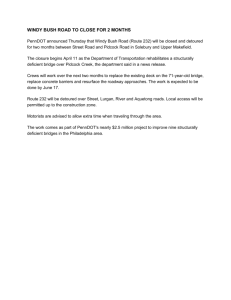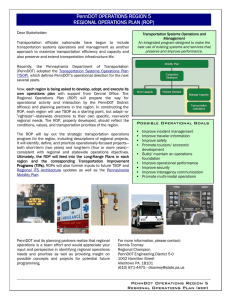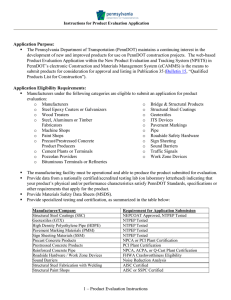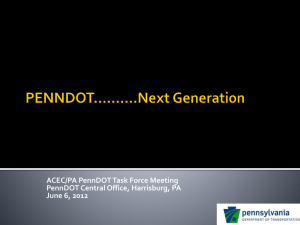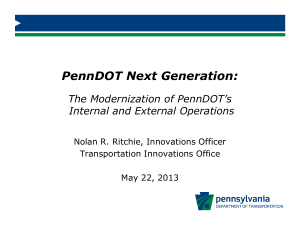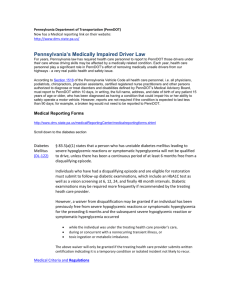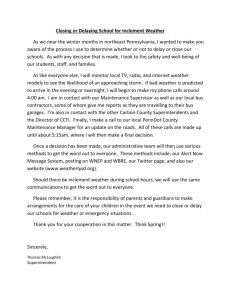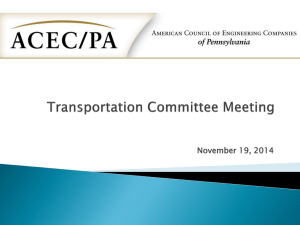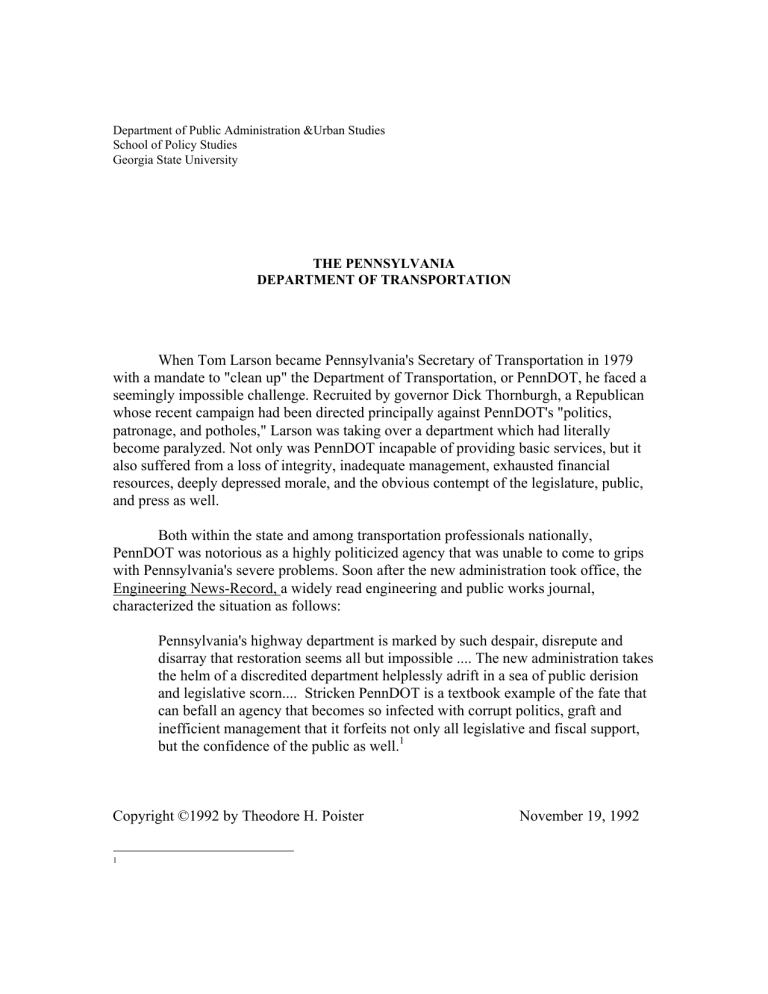
Department of Public Administration &Urban Studies School of Policy Studies Georgia State University THE PENNSYLVANIA DEPARTMENT OF TRANSPORTATION When Tom Larson became Pennsylvania's Secretary of Transportation in 1979 with a mandate to "clean up" the Department of Transportation, or PennDOT, he faced a seemingly impossible challenge. Recruited by governor Dick Thornburgh, a Republican whose recent campaign had been directed principally against PennDOT's "politics, patronage, and potholes," Larson was taking over a department which had literally become paralyzed. Not only was PennDOT incapable of providing basic services, but it also suffered from a loss of integrity, inadequate management, exhausted financial resources, deeply depressed morale, and the obvious contempt of the legislature, public, and press as well. Both within the state and among transportation professionals nationally, PennDOT was notorious as a highly politicized agency that was unable to come to grips with Pennsylvania's severe problems. Soon after the new administration took office, the Engineering News-Record, a widely read engineering and public works journal, characterized the situation as follows: Pennsylvania's highway department is marked by such despair, disrepute and disarray that restoration seems all but impossible .... The new administration takes the helm of a discredited department helplessly adrift in a sea of public derision and legislative scorn.... Stricken PennDOT is a textbook example of the fate that can befall an agency that becomes so infected with corrupt politics, graft and inefficient management that it forfeits not only all legislative and fiscal support, but the confidence of the public as well.1 Copyright ©1992 by Theodore H. Poister 1 November 19, 1992 Larson, who had accepted the post reluctantly, had previously conducted several critical analyses of the Department's highway and fiscal policies and was therefore familiar with many of the problems to be overcome. Looking back, he says that PennDOT's plight was well known by 1978: "First, it was known by the abominable conditions of the roads and bridges, which were quite literally falling apart. The Parkway through Pittsburgh had shoulder drop-offs up to 12 inches. Interstate 81, going north towards Binghamton, New York, was speed-limited to 35 miles per hour. Rural roads throughout the northern tier, in particular, were ravaged by unbridled truck use, severe weather, and essentially no maintenance. "But that was not all of it. The other most visible service area, the providing of licenses and titles, had fallen into total disrepair. People could not count on getting drivers licenses on time. They could not count on being able to get a vehicle registration after the vehicle had been bought and paid for. And monies paid for these services were deposited when and if employees could get around to it. These two symbols of service--road conditions and delivery of paperwork for drivers and vehicles--pointed up the plight of PennDOT. "The General Assembly had only limited ways to cope. Even though both the House and Senate were under Democratic control, as was the Governor's Office at that time, there was an unwillingness to pass legislation to provide more money. And the typical public sector solution is to throw away money at problems. Pennsylvania General Assembly members, however, even with strong political dominance, refused to do so because things were so bad." Taking office in January, 1979, however, Larson quickly discovered that things at PennDOT were in much worse shape than even he had imagined. Not only had the highway construction program ground to a halt because of a lack of responsible fiscal management, but, more important, the maintenance effort was nearly nonexistent, and the state's system of 45,000 miles of highway and 27,000 bridges was in a shambles. It is worth noting that Pennsylvania's is the third largest system in the country, after Texas and Virginia, and perhaps the most difficult to maintain due to the variety of roads by age, type and construction, and the additional hazards of a northern climate. Moreover, the organization itself was weak. Of the more than 15,000 employees at PennDOT at the time, roughly 11,000 worked in the field in county maintenance units. These units were headed by political appointees who were not really under the control of the Secretary or the official chain of command. There was no professional management in these operations. Most jobs were filled by the patronage system, and much of the 2 workforce was unqualified to do the work. Half of the equipment was down at any one time, and relatively little maintenance work was actually completed. In the central office highway bureaus, the ranks of the professional engineers had suffered through massive furloughs, abuse from the political hacks, the virtual shutdown of much of their work, and a lack of leadership which left them directionless and in a state of despair. Elsewhere in the department things were not much better. In the Safety Administration, which was responsible for licensing Pennsylvania's 7 million drivers and registering their 7.3 million vehicles, the average turnaround time for a vehicle title was about 30 working days, while driver's license renewals required 9 working days. Mismanagement and neglect of these functions over the years had resulted in a sluggish bureaucracy that lacked the capability, and any incentive, to bring the performance of routine operations up to par. In the words of one observer: "By the late 1970s the Safety Administration had collapsed, and the lawyers kept things going." The routine procedures for carrying out the approximately 25 million transactions per year could best be described as "Cro-Magnon," and start-up conditions in 1979 seemed hopeless. When new managers came into the Bureau of Motor Vehicles, they literally found "boxes full of checks lying around on the floor"; fees had been collected but never deposited. Planning efforts were devoted to producing a fiscally unconstrained Twelve-Year Program that was little more than a "wish list." The process for developing and administering PennDOT's budget, about $1.1 billion in 1979, provided little information or leverage for management to influence the allocation of resources. Of more immediate concern in a department near the point of bankruptcy, there was no cash management system to ensure even short-term solvency. PennDOT In part, PennDOT's problems could be traced all the way back to its origins. The old highway department was created in 1916 under Governor Gifford Pinchot who, in keeping with the "good roads movement"d nationally at the time, wanted to help "get the farmers out of the mud." Accordingly, over time selected local roads, primarily in rural areas, were designated as legislative routes and added on to a state "systems." These dirt roads were then upgraded with a thin "pie crust" surface and became the responsibility of the Department's highway supervisors established in each of the 67 counties. 3 The current legacy of this initiative was two-fold. First, some 13,000 of PennDOT's 45,000 miles of highway were in reality very low volume, local use roads which simply did not belong on the state system and were not well built in the first place. Secondly, the maintenance side of the Department remained highly decentralized and largely under the control of local politicians, constituting a kind of parallel organization to the construction oriented professional engineering units that had since come to dominate PennDOT,s central office. Numerous factors had converged to create the problems facing PennDOT in 1979, but a real watershed in the Department's evolution was a policy decision taken in the 1960s to finance, through bonds, a very large program of new highway construction. The goals of this program were to make a quantum leap in system capacity, to make Pennsylvania a model for freeway construction, and to open the state's industries and markets to the world. The concept was bold, but the means to pay for it were lacking. The program, moreover, failed to take full advantage of available federal funds. The result was hundreds of unfinished projects including portions of bypasses around most of the state's major communities, a $2 billion debt, and a great loss of respect by an irate citizenry. Deteriorating conditions were further exacerbated by the creation, in 1970, of the multimodal Department of Transportation to replace the Department of Highways. While from a policy perspective this was certainly an enlightened move, and one being taken by many states at about that time, its implementation was not well thought out in terms of managerial requirements. Creation of the DOT brought the licensing and titling functions into the Department for the first time and gave PennDOT responsibility for the areas of aviation and mass transit. Without really being properly geared up to absorb and integrate these activities, the existing management systems were overloaded to the point where breakdown was nearly inevitable. According to Larson: "What happened then should have been predictable. The agency became more fragmented rather than pulling itself together as a department of transportation. The professional engineers managed, to the best of their ability, the remnants of the construction program that finally ground to a halt in 1977. From then on, they tried to hold on to such things as they could, such as a small safety construction program. "The political arm, the county superintendents, disregarded the rest of the department and did what they had been doing for years. They tried to feed politicians with promises and hoped somehow that their deficiencies in road maintenance could be laid at someone else's doorstep. Obviously, that couldn't work forever. 4 "As department officials, lacking in professional abilities, managerial experience, and political forthrightness in an increasingly impossible situation, delayed and doubletalked their way through day-by-day departmental affairs, PennDOT sank into a state of paralysis. Both the Interstate and the Appalachian highway construction programs ground to a halt, allowing hundreds of millions of dollars in federal aid lapse. The maintenance program fell apart and the roads turned into a morass of potholes and breakups. Finally, the technical ability to deliver the paperwork for licenses and driver registrations fell into total disrepair." Tom Larson These forces led to the dire situation that faced the Thornburgh administration. It was apparent that remedying the immediate problems would require confronting some fundamental flaws in the system. As a candidate for Governor, Thornburgh had issued a succinct statement of objectives for a "new PennDOT", and the most important of these included: • Eliminating the abuses of the traditional patronage system and stressing professionalism and merit in hiring and promotions. • Eliminating criminality and corrupt practices by the most aggressive actions possible. • Achieving full utilization of available federal funds. • Reorganizing PennDOT and restoring its capacity to deliver a product.2 Soon after the election, Thornburgh interviewed Dr. Thomas D. Larson, a professor of civil engineering at Penn State University, and subsequently offered him the job of Secretary of Transportation. Larson, who was serving on the incoming administration's transition team for transportation, at first declined the offer, but after additional persuasion from the Governor-elect, he finally agreed to accept the post for an 18 month period. Larson knew that in some ways he was an ideal choice to become the new Secretary. He was at once an outsider to state government, with a "Mr. Clean" image and no political obligations, as well as a professional engineer who was already quite familiar with many of the policy issues and problems surrounding PennDOT. On the other hand, 5 although he possessed very effective communications and interpersonal skills, he had never managed anything larger than a university research institute. Over in the legislature 2 the initial reaction to Secretary Larson was guarded; it was generally conceded that he was a sincere, honest individual committed to serving the public, but his management abilities were as yet unproven. Although he was seen as a capable professional with experience in transportation policy, he was now working for a governor, and many legislators wondered how he would perform in a political environment. In 1976, in his capacity as chairman of the state's Transportation Advisory Committee, Larson had led a fiscal review task force whose findings were published in a report entitled NewDirections for PennDOT.3 This report, which according to one staffer had been used as a "bible" during Thornburgh's campaign, set out several recommendations which were in the forefront of Larson's mind as he took over the driver's seat of the immobilized agency. These included (1) placing top priority on a maintenance program to preserve the existing highway plant, (2) taking strictly local-use roads off the state system and turning them back to local jurisdictions, (3) limiting any new construction to critical safety and structural deficiency problems and to significant capacity improvements on a core network of vital highways, and (4) most adamantly, prohibiting the issuance of any more bonds and prescribing the funding for any new construction on a "pay-as-you-go" basis. Essentially, Thornburgh's offer to Larson was an invitation, and a challenge, to implement the kinds of ideas he had been espousing for years as a critic of PennDOT. Larson was initially hesitant, in large part because he knew the immensity of the difficulties confronting PennDOT and was doubtful of the prospects of wresting the Department away from the political abuses that had all but crippled it. Thus he required, and received assurance from Thornburgh that during his administration the Department would be free from the kind of political interference that had plagued it in the past. People in Place After a few weeks in office Larson was shocked by the magnitude of the problems that faced him. First, he was dismayed by the qualifications of some of the individuals reporting directly to him, especially when he looked at the five deputy secretaries who were left over from the previous Democratic Administration of Governor Milton Shapp. For example, the Deputy Secretary for Administration, George Pulakis, who was responsible for personnel, finance and computer support, was experienced only in personnel and was a product and protector of the traditional political patronage system. 6 3 The Deputy Secretary for Safety Administration, who was responsible for the work of 1,200 employees processing 25 million transactions annually, had previous experience limited to auto sales. Reports were that he spent two or three days per week at a small branch office in Pittsburgh; coincidentally, his home and business were also located in the Pittsburgh area. The Deputy Secretary for Planning, Ray Seaman, who had responsibility for coordinating with local planning agencies and developing federal aid programs, was a career civil servant filling the position in an acting capacity. While he was a competent technician, Seaman had not demonstrated any particular leadership potential or inclination to engage proactively in mobilizing resources or developing program priorities on a systematic basis. The Deputy Secretary for Local and Areawide Transportation, Ed Tennyson, was responsible for public transportation, aviation, rail and municipal grant programs. Although he had worked hard to establish PennDOT's mass transit assistance programs, which were generally more progressive than what most other states had in place at that point, he had little background or interest in his other areas of responsibility. Finally, Dave Sims, the Deputy Secretary for Highways, was a professional engineer who had been promoted up through the ranks of the construction bureaucracy. While he had served on the fiscal review task force with Larson and publicly supported its recommendations for limiting new construction to "pay-as-you-go" funding and switching to a "maintenance first" priority, he was identified with the construction program and had little familiarity with maintenance needs or activities. Furthermore, it was becoming apparent that many senior managers in PennDOT, such as the director of personnel and the budget director, were career bureaucrats who were comfortable with the traditional system and unlikely to be particularly helpful in trying to change the way the Department operated. At the outset, there were only two other "fresh faces" coming on board with Larson whom he could count on to help turn this entrenched bureaucracy around. One was Kant Rao, a young assistant professor of business administration at Penn State who was a levelheaded analyst of transportation policy issues and a "whiz kid" in finance and computer systems. The other was Bill Green, an energetic public relations expert who had worked for the Thornburg election campaign and was now PennDOT's new Press Secretary. New deputies could be named, but they were gubernatorial rather than secretarial appointments. 7 Startup Conditions From interviews with incumbent division heads and bureau chiefs and information collected by other staff, a more complete picture of PennDOT's problems began to emerge: 1. During the four preceding years, 63 PennDOT employees had been indicted and 47 convicted of wrongdoing, and the engineer who headed the internal investigations unit indicated that many more investigations were under way that could lead to more indictments. Common corrupt practices included taking bribes for letting contracts, commanding kickbacks in the leasing of heavy equipment, employees having conflicts of interest in companies doing business with PennDOT, the knowing acceptance of substandard or defective materials, and employee theft of 4 gasoline and other materials from the Department.4 Perhaps the most abhorrent practice was that of "macing" or soliciting political contributions. Employees in many of the counties and in central office units were regularly assessed a percentage of their wages by the political party in power in order to remain on favorable terms and keep their jobs. 2. A network of holdover political appointees of the prior administration existing in all the senior offices of the Department and in all the districts. Forming a kind of ushadow government* of individuals who did little or nothing productive for the Department but served only to keep tabs on PennDOT and report on its activities to political officials outside the Department, some five hundred of these political commissars had been identified. in addition, an organizational analysis identified nearly 100 middle management positions that lacked any real functional requirements to justify them. 3. One problems with the entire Highway Administration was its top-heavy organization, reflected in Exhibit 1. Immediately under the Deputy Secretary was the Chief; Engineer, who in turn had three deputies: one responsible for the districts in the eastern part of the state, one over the western districts, and a third who supervised the six central office bureaus which were intended to provide support functions for the districts and counties. Geographically, the field offices were divided into eleven engineering districts headed by district engineers who reported to the Deputy Secretary for Highways through the Chief Engineer and a Deputy Chief Engineer. The District Engineers were directly responsible for the actual work of planning, design, and supervision of construction projects and had professional staff on board to do this work. Each district was further organized by county for the maintenance function, with the 67 county highway superintendents reporting, at least nominally, to the district maintenance office and chief of operations. 8 4 4. More problematic was the lack of activity in much of the highway bureaucracy and the siege mentality that had taken hold in many parts of the operations as a result of the collapse of the construction program. In an interview early on in his tenure, Secretary Larson was quoted as saying "There was no construction, no maintenance. There were 15,000 employees consuming a payroll of $300 million and doing nothing." In prior eras, Pennsylvania had been recognized for its corps of professional engineers who had been leaders nationally in the fields of design, construction, and operations. A decade earlier, when PennDOT embarked on its massive $10 billion construction program, the complement of design engineers and construction inspectors had reached its peak, and their influence on departmental policy was almost absolute. In 1979, however, PennDOT's construction program was moribund, and its total complement -- 23,000 in 1968 -- was down to 15,000 as a result of massive furloughs. Indeed, over a period of a few months in 1977, some 7000 departmental employees lost their jobs. The once-proud engineering staff was shell- shocked and about as demoralized as it could get. In talking with PennDOT employees, Larson found that the question uppermost on everybody's minds was "When will you have to schedule the next furlough?" Yet the employees in the central office bureaus and districts had little real work to do because there were so few projects on line. Larson's initial impression of the workforce was consistent with a comment made by a former Penn State colleague who had previously worked in the Department and characterized the bureaucrats there as primarily "just sitting around waiting for 4:30 or retirements." Ironically, a memo on the Secretary's desk when he first reported for work was a request for authorization to hire 2,300 people in order to restore a basic capability to design and oversee the construction of new highways. 5. The politically dominated highway maintenance operations at the county level presented a much more crippling barrier to PennDOT's performance. Approximately 10,000 individuals or two- thirds of the total work force were employed in the county maintenance "sheds", and traditionally there was a high turnover rate in the county supervisors, the assistant supervisors, and even the foremen when control of the Governor's office shifted from one party to the other. The county political party chairmen and state legislators traditionally had control over the appointment process, and the district engineers were typically informed by political operatives in the central office as to who their county highway supervisors would be. Under this system the district engineers were relatively powerless to direct the activities of their county supervisors, who tended to be much more responsive to their political sponsors outside the organization. Moreover, while in some cases individuals with business experience were appointed to these posts, the array also included shoe salesmen, schoolteachers, football coaches, dairy farmers, drillers' truck drivers, and barbers. In fact, 15 of the incumbent 9 highway supervisors were Democratic county chairmen. With a new Republican governor, Republican county chairmen were expecting the highway organizations to revert to their control. Some state legislators were making key budget votes contingent on the appointment of party selections to the maintenance supervisor positions. 6. PennDOT was delivering virtually no product to Pennsylvania taxpayers. Road repair, construction, and bridge replacement activities had dropped to their lowest levels in two decades. Pennsylvania was roundly proclaimed the pothole capital of the world, and the image of the PennDOT highway crew was a group of workers standing around leaning on shovels. When work was performed on the roads, it tended to be of the "duinp and run* variety or "election day specials" which had little lasting effect on serviceability. The New Directions report had shown that by 1976 the maintenance backlog in terms of needed resurfacing, bridge repair, guardrail repair and road widening projects had soared to $858 million. 7. To put it bluntly, PennDOT was nearly bankrupt. The capital program was nonexistent, with a moratorium on new construction projects in effect for over a year as the result of relying entirely on the use of bonds to obtain state funds to use as a match for federal aid programs. moreover, the bond funds themselves were not targeted strategically so as to maximize the leverage on federal funds for use on needed projects. Without other state funds available, in the two years prior to the new administration taking office, nearly $500 million of federal-aid funds had been forfeited by Pennsylvania. As late as 1976, PennDOT issued $350 million in bonds to help finance construction projects with a total cost of approximately $700 million (whereas the ratio of state matching share to federal funds should have run about one to four). Pennsylvania had left more earmarked federal funds unused than any other state and at present had $100 million sitting in Washington awaiting state matching funds. As a result of all of this, by 1978 Pennsylvania had amassed $2.2 billion of highway bonded debt, and the department's debt service was running about $200 million a year and beginning to strangle the overall budget. As shown in Exhibit 2, the budget inherited by Larson when he came into office allocated $456 million to high maintenance programs. According to the New Directions report, an additional $563 million, over and above this normal maintenance budget, would be required over the next five years simply to provide a "bare bones" level of maintenance and prevent the backlog from growing larger. 8. On the verge of bankruptcy, PennDOT did not have any reliable means of knowing how much money it currently owed and was owed, much less did it have accurate forecasts of receipts and payoffs in the future. There simply was no cash flow management in the Department. Furthermore, it had become apparent to Larson that the incumbent 10 budget director, a career civil servant who played it close to the chest and did not involve staff in the budget making process, was not going to reveal the intricacies of the Department's budget and moreover was illegally diverting funds from one category to another on his own authority. (While the Commonwealth of Pennsylvania had been using a program budgeting system since 1969, PennDOT had never converted to the program budget as its real resource allocation mechanism. Rather, it developed its budget on the traditional line-item basis and then obligingly "crosswalked" the figures into a program format to satisfy the Governor's Budget Office.) Meanwhile, the motor license fund cash situation was so desperate that the Department had to borrow $25 million from the general fund in order to meet grant obligations to municipalities. 9. In contrast to the budgeting process, PennDOT's traditional programming process was highly fragmented and based on the unrealistic assumption of abundant resources. Briefly, the Department maintained a Twelve Year Program which contained all projects which might ever be carried out. Anticipated financial resources were allocated among the 67 counties, and projects were developed and prioritized by the district offices and local county planning commissions. These projects were then reviewed and aggregated into an overall program for a year and then recommended to the Transportation Commission, which would formally adopt the program. Actual contract lettings, however, did not necessarily adhere to the priorities established by the twelve year program; rather, they tended to be let on a "first come, first serve" basis to award as many contracts as possible in any given year. Programming decisions for non-capital, primarily categorical grant programs were fragmented among various organizational units in the Department where they tended to develop a bureaucratic life of their own. Furthermore, PennDOT had no formal pavement management system to plan and prioritize highway maintenance activities, and undertook no systematic highway condition surveys to track maintenance needs and facilitate comparisons over time or across districts and counties. 10. With respect to external support, the Pennsylvania General Assembly had introduced over 20 bills to dismantle PennDOT. Soon before the new administration took office the General Assembly had established a special Oversight Committee to investigate the Department's poor performance. The Department's four person press office was besieged by hostile inquiries and complaints about everything from potholes to lost drivers licenses. On that score, legislation for both photo ID drivers licenses and staggered vehicle registrations had been passed by the legislature the preceding year, but neither had been implemented yet. Finally, a survey of newspaper stories about PennDOT conducted by Bill Green showed that over 90 percent were negative. 11 Problems, Opportunities, and Strategies As full realization of the magnitude and pervasiveness of these problems began to sink in, Dr. Larson wondered more than once whether it had been a mistake to leave the ivy halls of State College to come to Harrisburg as the neophyte administrator of this large and crippled agency. But he had made a personal commitment to the new Governor, and moreover he was committed to the principle of restoring integrity to PennDOT and service to the citizens of Pennsylvania. A knowledgeable observer of transportation issues and an astute critic of PennDOT in the past, Larson knew that he had to hit the ground running. Beyond the problems and hostility, there were resources and opportunities he could take advantage of, but there were also risks involved. True, some general goals had been established through the fiscal review and the election campaign, but he still needed a strategy for beginning to turn the Department around. Where to begin? 12 1. Notes "Pennsylvania Officials Pledge PennDOT cleanup," Engineering News-Record (January 25, 1979). 2. Richard L. Thornburgh, "Making Pennsylvania Proud Again -- What the People of the Commonwealth May Expect of a Thornburgh-Scranton Administration" (undated). 3. State Transportation Advisory Committee, New Directions for PennDOT: A Fiscal Task Force Review, Thomas D. Larson, Chairman, April 7, 1976. 4. Pennsylvania Crime Commission, Macing and Extortion in the Pennsylvania Department of Transportation, Pennsylvania Department of Justice, Harrisburg, July 1978. 13 EXHIBIT 2 PennDOT Budget, FY 1979 (in thousands of dollars) Use of Funds 456,769 Highway Maintenance 184,402 Highway Construction 115,561 Mass Transit Programs 198,623 Debt Service 33,762 Safety and Licensing 20,358 Department Administration 7,363 Aviation 3,486 Other Activities 86,778 State Police Activities 17,868 Other Departments 26,125 Local Government Funds $1,251,095 Total FY 1979
